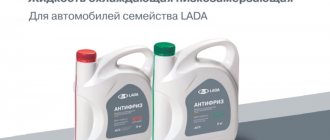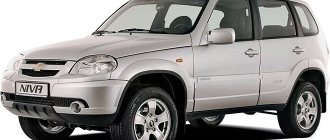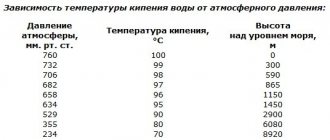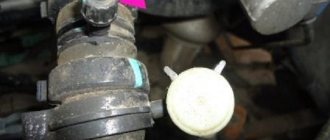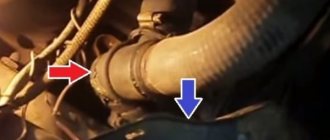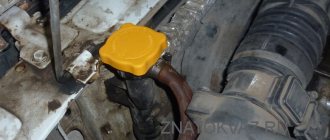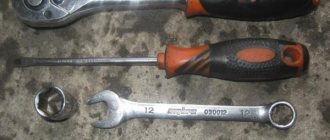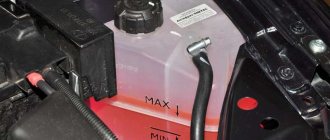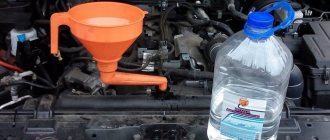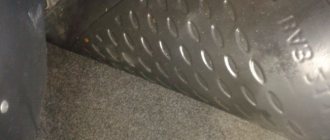Purpose of coolant on VAZ 2107
It’s easy to guess the purpose of the coolant from its name. It serves to remove excess heat from the engine. It's simple: in any internal combustion engine there are many rubbing parts, which during operation can heat up to a temperature of 300°C. If these parts are not cooled in time, the engine will fail (and the pistons and valves will be the first to suffer from overheating). This is where coolant comes to the rescue. It is supplied to a running engine and circulates there through special channels, taking away excess heat.
Once heated, the coolant goes into the central radiator, which is constantly blown by a powerful fan. The liquid cools in the radiator and is then sent back to the cooling channels of the engine. This is how continuous liquid cooling of the VAZ 2107 engine is carried out.
conclusions
We have described all the reasons why the use of antifreeze in VAZ-2114 engines will be much more effective. After reading this article, you should make the right choice and, if necessary, carry out a complete replacement of your car's cooling system. How to properly carry out this work is described in detail in this article.
Every internal combustion engine must be constantly cooled, otherwise it will not function properly. According to established data, the efficiency of current engines is 30% and 45% for diesel engines. It follows from this that thirty percent of the energy that is formed during the combustion of fuel is useful, the rest is spent to heat the engine and is released into the air.
To avoid engine overheating, it is necessary to use cooling systems that operate on the basis of appropriate liquids. Excess heat is thereby released into the surrounding atmosphere. Coolants allow you to control the temperature during engine operation, save on fuel consumption, increase the power of the internal combustion engine, and also prolong the serviceability of parts. Many car enthusiasts think that it is better to use antifreeze or antifreeze, especially during the period when it is necessary to protect the engine.
About antifreeze and antifreeze
It should be said right away that dividing coolants into antifreeze and antifreeze is accepted only in Russia. To understand why this happened, you need to answer the question: what is coolant anyway?
As a rule, the base for the coolant is ethylene glycol (in rare cases, propylene glycol), to which water and a set of special additives are added to prevent corrosion. Different manufacturers have different sets of additives. And all coolants on the market today are classified according to the technologies for producing these additives. There are three technologies:
- traditional. Additives are made from salts of inorganic acids (silicates, nitrites, amines or phosphates);
- carboxylate. Additives in carboxylate fluids are obtained only from organic carbonates;
- hybrid. In this technology, manufacturers add a small percentage of inorganic salts (most often phosphates or silicates) to organic carbonate additives.
Coolant made using traditional technology is called antifreeze, and liquid made using carboxylate technology is called antifreeze. Let's take a closer look at these liquids.
Antifreeze
Antifreeze has several advantages. Let's list them:
- protective film. The inorganic salts contained in antifreeze form a thin chemical film on the surface of the cooled parts, which reliably protects the parts from corrosion. Film thickness can reach 0.5 mm;
Of course, antifreeze also has disadvantages. Here they are:
- small resource. Antifreeze quickly becomes unusable. It needs to be changed every 40–60 thousand kilometers;
- effect on aluminum parts. The additives contained in antifreeze negatively affect the aluminum surfaces in the main radiator. In addition, antifreeze can form condensation. These factors significantly reduce the service life of aluminum radiators;
- influence on the water pump; The tendency to form condensation can also have a detrimental effect on the VAZ 2107 water pump, leading to premature wear of its impeller.
Antifreeze
Now let's look at the pros and cons of antifreeze. Let's start with the pros:
- long service life. On average, six liters of antifreeze are enough for 150 thousand kilometers;
- temperature selectivity. Thanks to carbonate additives, antifreeze can more actively protect the engine surface that is hottest than others;
And antifreeze has only one disadvantage: high cost. A canister of high-quality antifreeze can cost two or even three times more than a canister of good antifreeze.
Taking into account all the above advantages, the vast majority of VAZ 2107 owners opt for antifreeze, since saving on coolant has never led to anything good. Almost any antifreeze, both domestic and Western, is suitable for the VAZ 2107. Most often, car owners prefer to use Lukoil G12 RED antifreeze.
Other, less well-known brands of antifreeze are Felix, Aral Extra, Glysantin G48, Zerex G, etc.
Antifreeze
Antifreeze was created in the USSR in response to imported antifreeze. What does the word “TOSol” consist of? “TOS” stands for “Technology of Organic Synthesis” (that was the name of the department where antifreeze was invented), and the ending “OL” indicates that the coolant contains alcohol. Antifreeze was developed over 3 years in the late 1960s at the GosNIIOKhT Institute. Antifreeze was first used for a Zhiguli car. Therefore, many people associate the word “antifreeze” with “Zhiguli”.
Antifreeze comes in only two colors: red and blue. But some manufacturers can paint it in whatever colors they want, which can cause confusion among auto repairmen and motorists.
- Red antifreeze can be used at temperatures down to -65°C. It has more alcohol than blue.
- Blue antifreeze can be used at temperatures down to -40°C.
Antifreeze contains:
- Dye.
- Distilled water.
- Ethylene glycol (or otherwise dihydric alcohol).
- Various additives.
The secret to how antifreeze works is in the additives . They are of chemical origin: nitrites, phosphates, borates (borax), silicates and others. Their benefit is to protect system parts from corrosion, which can be caused by water and alcohol over time. Antifreeze is completely changed once every two years. If this is not done, the dry residue will clog the pipes, which will lead to jamming of the motor.
The chemical composition of antifreeze has not changed for 40 years; it was prepared the same way before, and is still made today, in exactly the same composition. There are no scientific developments to improve the formula. Currently, no one adheres to the original recipe. Private companies make antifreeze according to their own recipe, but no one has truly improved its composition. There is a high risk of running into poor quality coolant.
Flushing the cooling system
Flushing the cooling system is a very important procedure, since the cooling efficiency of the VAZ 2107 engine depends on it. At the same time, many car enthusiasts prefer not to flush the cooling system, but to fill in new antifreeze immediately after draining the old one. As a result, the remnants of the old antifreeze are mixed with the new coolant, which has an extremely negative effect on its performance. That is why it is strongly recommended to flush the engine cooling system before adding new antifreeze. This can be done either with water or with the help of special compounds.
Flushing the cooling system with water
It should be said right away that it is advisable to use this washing option only when there is no good washing liquid at hand. The fact is that ordinary water contains impurities that form scale. And if the driver still decides to flush the cooling system with water, then the best choice in this situation would be distilled water.
Water rinsing sequence
- Distilled water is poured into the expansion tank of the VAZ 2107.
Flushing the cooling system with a special compound
Flushing the cooling system with a special composition is the best, but also very expensive option. Because cleaning products effectively remove residual grease, scale and organic compounds from the system. Currently, VAZ 2107 owners use two-component flushing fluids, which contain both acids and alkalis. The most popular liquid is LAVR. Cost - from 700 rubles.
Sequence of flushing the system with a special liquid
The sequence of flushing the cooling system with a special composition is practically no different from the sequence of water flushing mentioned above. The only difference is the operating time of the motor. This time must be clarified (it depends on the composition of the selected flushing liquid and must be indicated on the canister with flushing).
Need for cooling
Cars that move without coolers can make an emergency stop at any time, during which the engine will seize due to overheating. It is no longer possible to continue driving in such a car; only evacuation will save you. A large number of engines fail as a result of overheating, so drivers begin to take care of their property in advance and try to understand what is better to pour into the car’s cooling system: antifreeze or antifreeze.
In fact, antifreeze and antifreeze are similar concepts, which have repeatedly appeared on the Internet, but in Russia they are separated and have individual characteristics.
The Arteco organization is confident that 22% of car damages are directly related to unstable operation of the cooling system, and 40% at least somehow overlap with this. Based on this, in order to avoid financial waste and loss of personal time, you need to approach this issue responsibly and understand what is better: antifreeze or antifreeze for your own car, be it a VAZ or a foreign-made car.
The constituent elements of cooling substances are:
- ethylene glycol mixtures;
- propylene glycol, which happens in rare cases;
- water;
- corrosion inhibitor additives.
The difference between coolers from different manufacturers is the additive production technology.
Replacing antifreeze on a VAZ 2107
Before starting work, let's decide on the tools and consumables. Here's what we need:
- canister with new antifreeze (6 liters);
- open-end wrenches included;
- a bucket for draining old antifreeze.
Sequence of work
- The car is installed on an overpass (or, as an option, on an inspection hole). It is better if the front wheels of the car are located slightly higher than the rear ones.
- On the dashboard you need to find a lever that controls the supply of warm air into the cabin. This lever moves to the far right position.
Video: draining coolant from a VAZ 2107
So, it is quite possible to replace the coolant on a VAZ 2107 on your own. Even a novice car enthusiast who has held a wrench in his hands at least once can cope with this procedure. All that is required for this is to strictly follow the above instructions.
How can I find out what kind of coolant was filled in at the factory?
In the vast majority of cases, it is very easy to find out the brand of antifreeze that was initially poured - just look at the sticker placed on the tank. This sticker always indicates in large letters the liquid with which the system was filled (and which it is recommended to add as needed).
In the vast majority of VAZ 2114 cars, the liquid filled at the factory is either Felix TC-40, produced in Dzerzhinsk, or CoolStream Standart 40, produced in Klimovsk. They can also be distinguished by color.
The first is bright green, the second is either green-yellow or faint green, in both cases there is slight fluorescence. Both of these liquids are antifreeze (belonging to class G11), and they can only be mixed with other liquids from this class.
Many people believe that Antifreeze is much worse in quality than antifreeze, so they cannot be mixed. This is incorrect - the reason lies not in the quality or acidity of the medium, but in the very different densities of these two liquids.
If it is not intended to replace the coolant with a liquid of a different category (for example, antifreeze for antifreeze), then you can add it without draining the entire cooling system. Otherwise, this operation will be strictly necessary.
How to fill antifreeze into a VAZ
After repair work related to the cooling system, for example replacing the pump on the seven, the radiator, or the head gasket, you need to fill in the coolant. In a classic carburetor or injection system, you need about 10 liters to fill the system.
In order to fill in antifreeze (antifreeze) and not get an air lock, which during operation will lead to engine overheating and poor heater performance, several conditions must be met:
- position the car (or jack it up) so that the front end is higher;
- loosen the clamp and remove the hose from the throttle valve on the injector or the hose from the manifold on a carburetor engine;
- open the plugs on the expansion tank and radiator;
- check if the drain plugs are closed;
- Slowly pour antifreeze into the radiator through a funnel. It will not go away quickly since the cold thermostat will be closed, to speed up the process the hose is removed from the throttle assembly;
- fill the radiator to the brim and close the cap;
- Reinstall the hose going to the throttle;
- fill the tank to the level and close it;
- start the engine and let it run;
- turn off the engine and add fluid if necessary
There is another way to ventilate the cooling system, but it is shown in this video:
The machine is ready for use.
2 Comments on “How to fill antifreeze into a VAZ”
I replaced the antifreeze with a new one, but now I can’t fill the full system. Only 7 liters will fit, at least you need to fill a couple more. What is the reason?
The reason may be a closed heater tap or antifreeze remaining in the system.
What is better antifreeze or antifreeze?
Considering the information above, we can make an unambiguous conclusion that antifreeze, as one of the brands of antifreeze, does not have the best set of additives.
Thanks for subscribing!
What can the use of antifreeze lead to:
- Corrosion of internal elements of the cooling system due to untimely replacement
- Engine overheating due to an excessively large layer of additives on the inner surface
- Foaming and, as a consequence, boiling of the liquid, which has a number of separate consequences
If you do not replace the antifreeze in a timely manner, your engine may be seriously damaged. And you need to change antifreeze, as mentioned above, every 30,000-40,000 km. As for antifreeze, we repeat, it is not a specific brand and may contain various additives - both good and bad.
The conclusion is that it is better to fill in any modern antifreeze than antifreeze.
How to properly replace antifreeze on a VAZ 2107?
Coolant plays an important role in the engine cooling system. Without it, the engine will not be able to operate for a long time. Thanks to antifreeze, the life of the engine is extended due to the fact that it is constantly cooled.
Why then is it necessary to change antifreeze for the VAZ 2107? As it is used, the coolant loses its original properties and is unable to cool the engine. Timely fluid replacement is a process that can be easily done at home if you know the replacement procedure step by step, which will be discussed in the article.
Antifreeze characteristics
Before deciding what is better to use - antifreeze or antifreeze - you need to understand the general characteristics of the products. Antifreeze is a coolant. It does not freeze at low temperatures. It includes:
ATTENTION! A completely simple way to reduce fuel consumption has been found! Don't believe me? An auto mechanic with 15 years of experience also didn’t believe it until he tried it. And now he saves 35,000 rubles a year on gasoline! Read more"
- ethylene glycol;
- water;
- inhibitors.
This combination gives the product anti-corrosion properties. It is available in two forms: ready-mix and concentrate. The latter needs to be bred independently. The liquid is also distinguished by color. Red antifreeze is considered the best option. It consists of an organic base that effectively performs its tasks. A small addition of carboxylic acid prevents the formation of films. The liquid removes small areas of corrosion.
The green mixture is a combination of organics and chemicals. It is less efficient, reduces heat dissipation and contributes to the appearance of plaque, although its cost is much cheaper.
According to GOST, coolant, be it antifreeze or antifreeze, should not contain mechanical impurities. It should be transparent and uniform. Antifreezes of different classes may have the same color, but this does not mean that they can be mixed with each other. Even when mixing antifreeze from different manufacturers, a suspension of small but solid particles may appear.
We recommend: About mixing antifreeze with water: is it possible?
And when mixing mineral and synthetic antifreeze, even if they are of the same color, a cloudy sediment is almost guaranteed to form, which will certainly settle in the car’s cooling system. This sediment will eventually clog the radiator, stop the pump and cause the engine to boil.
If you mix antifreezes of the same category, but of different colors and manufacturers, then most likely their characteristics (for example, freezing and boiling points) will not change. However, after heating, a suspension of barely noticeable solid particles may form in such a mixture. It is impossible to say unambiguously or somehow predict how this “suspension” will behave in the engine cooling system.
To avoid problems with your car, we do not recommend engaging in such dubious experiments on mixing antifreeze, and we recommend periodically flushing the engine cooling system.
Experience shows that, relatively safely and without dire consequences for the engine, mineral (G11 or antifreeze) and organic (G12) antifreezes can only be mixed with high-quality universal antifreeze of the G12++ class. Therefore, if you don’t know exactly what kind of coolant is in your car, then you shouldn’t risk it again - only top up with universal antifreeze.
Timing for replacing coolant in VAZ 2107
The purpose of the coolant in the VAZ 2107 is to remove excess heat from the car’s engine. Indeed, during operation, many parts of an internal combustion engine reach temperatures of 300 degrees C. If the engine is not cooled in time and sufficiently, it will fail. Coolant solves this problem; it is supplied to a running engine, flows through the channels, thus taking away excess heat from the internal combustion engine.
After heating, the coolant goes into the central radiator, which is constantly blown by the fan. After cooling in this unit, the liquid returns to the engine cooling channels. This is the procedure for continuous liquid cooling of the VAZ 2107 engine.
The general principle of operation of the VAZ 2107 cooling system can be studied using the diagram below.
How to understand what kind of coolant is required for a VAZ 2107 - antifreeze or antifreeze? Since we are talking about Russian cars, we should distinguish between concepts such as antifreeze and antifreeze to clarify concepts.
It should be noted that such division and differentiation is accepted only in the Russian Federation. To answer this question, you must first understand: what is coolant?
So, the basis of the coolant is ethylene glycol, less often propylene glycol. Special additives are added to it, which protect against corrosion. Each manufacturer adds different types of additives.
Let us differentiate the coolants available on the modern market according to additive production technologies:
- traditional, in which additives are made from salts of inorganic acids: silicates, nitrites, amines, phosphates;
- carboxylate, additives are made from organic carbonates;
- hybrid, consists of a mixture of organic carbonate additives and inorganic salts (in smaller quantities, including phosphates or silicates).
So, the main difference between antifreeze and antifreeze is that coolant made using traditional technology is called antifreeze, while coolant made using carboxylate technology is called antifreeze.
Advantages and disadvantages of using antifreeze
Pros:
- protective film. Thanks to the inorganic salts contained in antifreeze, a protective film is created on the surface of the cooled parts, protecting them from corrosion. The film reaches 0.5 mm. In the picture below you can see how antifreeze creates a protective layer, the disadvantage is that it interferes with heat removal;
- color change. If the driver forgot to change the coolant, a clue to the need for the procedure will be the color of the liquid, which is easy to notice just by looking into the car's expansion tank. The changes are that as the antifreeze loses its useful properties it becomes darker, and completely unusable antifreeze cannot be distinguished from tar;
- affordable prices. Coolant produced using traditional technology is 3 times cheaper than antifreeze.
Disadvantages of antifreeze:
- replacement frequency. Antifreeze has a short lifespan, becoming unusable after 50 thousand kilometers;
- negative impact on aluminum parts. The additives used to create antifreeze negatively affect the aluminum surfaces in the main radiator (which significantly reduces its service life);
- due to the tendency to form condensation, it negatively affects the water pump of the VAZ 2107, as a result - premature wear of its impeller.
Let's look at the advantages and disadvantages of using antifreeze
Pros:
- service life is longer - 6 liters of antifreeze is enough for 150 thousand kilometers;
- temperature selectivity - due to the presence of carbonate additives, antifreeze more actively protects the engine surface that is heated the most;
- antifreeze does not interfere with heat dissipation, and also protects corrosion areas with the help of local layers;
- long engine operation due to temperature selectivity and timely engine cooling with antifreeze;
- there is no condensation, which means antifreeze cannot damage the radiator and water pump of the VAZ 2107.
The disadvantage of antifreeze is obvious - its high cost. In terms of price, it is on average 3 times higher than antifreeze.
Antifreeze
Antifreeze is a liquid that does not freeze. They are used, for example, with salts and other chemicals that are generously sprinkled on roads in winter.
In the automotive industry, the term Antifreeze Coolant is used, and it is often written on antifreeze containers. This is a general name for various coolants for a car. Absolutely all coolants differ from each other by additional components (additives).
An interesting fact is that the basic composition of antifreeze is identical to antifreeze.
Antifreeze composition:
- Distilled water – from 5 to 7%.
- Sometimes glycerin is added.
- Propylene glycol (ethylene glycol) 90%. Dihydric alcohol has a freezing point of -12°C and a boiling point of +200°C.
- Additives and defoamers – from 3 to 5%.
Despite the fact that the composition is the same, some types of antifreeze have a huge difference from antifreeze. As a rule, the more expensive the coolant, the better the additives and additives.
Therefore, the most important difference between antifreeze and antifreeze is the presence of organic (or inorganic) acid and chemical additives. What are the benefits of additives and additives?
- Protection against metal corrosion that can be caused by water contained in the coolant.
- Antifreeze service life.
- Frost resistance.
- Boiling resistance.
- Antifreeze performance.
- Environmentally friendly.
If you suddenly decide to mix several different types of coolant with different additives in order to obtain a more “powerful” coolant, this can lead to unpredictable consequences. Therefore, there is no need to experiment.
Note! Antifreezes are not divided into classes based on color; their characteristics do not depend on this. Liquids are specially painted in different colors so that auto repairmen and car owners can distinguish them from each other and visually determine their temperature conditions. But some manufacturers change the color at their discretion, so confusion often occurs.
What classes of antifreeze exist? The answer is below.
Instructions for replacing antifreeze
Antifreeze, compared to water, is quite resistant to frost - it does not freeze. It is also not a source of scale, which means it does not clog the cooling system.
But, subjected to constant temperature influences and fluctuations, antifreeze loses its properties during operation:
- the boiling point decreases and accordingly becomes equal to the boiling point of water;
- The fluid may freeze, resulting in a cracked reservoir or cracked cylinder block.
For these reasons, it is necessary to change antifreeze at least once every six months. It is important to do this during seasonal car maintenance. Timely replacement of coolant will help avoid unpleasant consequences, unwanted repairs and unnecessary waste of money.
So, replacing antifreeze on a VAZ 2107 includes draining the antifreeze, flushing the cooling system (if necessary) and replacing the used coolant with new antifreeze or antifreeze.
You should first prepare the following materials and tools:
- canister with new antifreeze (6 liters);
- funnel;
- wrench “13”;
- open-end wrench “16”;
- key “12”;
- an empty container of 6-10 liters (a cut canister is often used);
- a clean rag made from natural fabrics;
- Protect your hands with gloves.
Drain
Draining antifreeze from the VAZ 2107 tank includes the following sequence of actions:
- Place the car on the inspection hole so that the front wheels of the car are higher than the rear ones;
- Move the lever (located on the dashboard) that supplies warm air into the cabin as far as possible to the right;
- Open the hood and unscrew the expansion tank cap;
- Unscrew the central radiator cap;
- Using a 16mm open-end wrench, unscrew the drain plug located on the cylinder block. Place a container prepared in advance, as liquid will begin to pour out. It may take up to 10 minutes to completely drain the spent fluid;
- Using a “12” wrench, unscrew the plug on the radiator drain hole, located in its lower part. A special bucket or container is used for draining;
- Remove the belt holding the expansion tank by hand. You should raise the tank as high as possible, thus draining the remaining antifreeze from the hose connected to the tank;
- After completing the procedure for draining antifreeze or antifreeze, the tank is installed in place, all drain holes are then closed and the cooling system must be flushed.
Flushing
Flushing the cooling system is an important procedure. It determines how effectively the VAZ 2107 engine will be cooled. A number of car owners believe that flushing the cooling system is a waste of time, and immediately fill in new antifreeze or antifreeze after draining the used fluid. This causes clean and dirty fluid to mix, negatively affecting performance.
You can flush the cooling system using either water or special products.
Cleaning OS with water
Flushing the cooling system with water is only allowed if there is no flushing liquid. The fact is that ordinary water contains impurities that contribute to the formation of scale. If the choice is water, it is better to use distilled water.
Sequencing:
- Water is poured into the expansion tank of a VAZ 2107;
- Let the engine idle for 30 minutes;
- After half an hour has passed, the engine is turned off and the water is drained;
- Repeat the procedure until the water drained from the system is as clean as the water being poured in;
- Stop the procedure after clear water appears.
Cleaning the OS with a special agent
You can also flush the cooling system with a product containing special impurities. This is a more expensive way to clean the system, but in the long term the most appropriate option, since the product removes from the tank:
- fat deposits;
- dissolves and removes scale from the tank;
- organic compounds.
Today, VAZ 2107 car owners use flushing fluids, the two main components of which are acids and alkalis. Car owners prefer LAVR, which costs from 700 rubles.
The sequence of actions when flushing the cooling system with a special liquid is no different from flushing with water. The only significant difference is the operating time of the motor, which is indicated on the canister of liquid.
After flushing the radiator tubes of a VAZ 2107 with LAVR, the positive result is obvious.
Bay
After the actions have been taken, it is time to fill in new antifreeze (or antifreeze, if such a decision was made by the VAZ 2107 car owner).
How to replace antifreeze on a VAZ 2107 injector? Sequencing:
- Open the radiator cap and insert a funnel into it;
- The following actions are carried out with the help of a partner. The plug is removed from the cylinder block and antifreeze is slowly poured in. At the same time, tighten the bolt, and as soon as the antifreeze flows out of the BC, the bolt is tightened. Such a maneuver will help eliminate the creation of air jams;
- Pour antifreeze into the radiator until it is completely filled;
- Pour antifreeze into the expansion tank until it reaches the radiator. Then screw on the tank cap;
- The tank is the last to be filled. The level corresponds to the norm. Upon completion of all procedures, the lid is screwed on;
- Start the engine and warm it up to operating temperature to check the proper operation of the cooling system. The cooling fan should work and the temperature should drop, which means the system is in working order.
This completes the replacement of antifreeze in the VAZ 2107 injector. There is no need for special knowledge or special equipment to perform this procedure. It is enough to have a set of tools and decide on a place.
You should also pay attention to the fact that antifreeze, like antifreeze, is a toxic substance. Consequently, a number of safety measures are observed when replacing coolant on a VAZ 2107:
- Do not dump antifreeze on the floor in the garage or on the ground in the yard. The liquid is poisonous and can harm the human respiratory system;
- Protect your skin and do not allow antifreeze to get on your hands or in your mouth. A number of motorists check the nature of the fluid used by dipping their finger into the reservoir. The consequences may be poisoning or burns;
- If antifreeze gets on your hands, face, eyes, or mouth, rinse with a stream of cold water and take the victim to a specialist, or call an ambulance. Antifreeze, like antifreeze, is first of all a liquid hazardous to health, and only then a necessary component for the proper operation of a VAZ 2107 car;
- Do not have a snack while working on replacing antifreeze in the VAZ 2107. In this way, you can swallow the evaporated toxic liquid;
- Wash your hands after completing the antifreeze replacement procedure. This is done several times with running water, after which the skin should be protected with a special cream (especially important if antifreeze gets on the skin of your hands).
By adhering to the described recommendations, the driver of a VAZ 2107 car will protect both himself and others from unpleasant consequences, poisoning, burns, etc.
How to distinguish fake antifreeze?
Always buy coolant from the same store (even if your best friend suggested a place where you can buy it for a very low price). In this case, the chance of running into a fake is very small. The container should not be transparent, the labels should be glued evenly. There MUST be approval marks , a trademark, the name of the company with which car manufacturers there is cooperation.
If there are defects in the plastic or if there are leaks, avoid this brand altogether. After all, if during the production of coolant they saved on packaging, then what can we say about the quality of the product itself. I would like to note that counterfeit antifreeze will cause more harm than high-quality antifreeze.
If you see inscriptions on the canister that the antifreeze meets the requirements or specifications of automakers (the following is a long list of different brands of Ford, Toyota, Mercedes, etc.), or “designed to meet the requirements”, “meets international standards”, “recommended for” , then do not believe these marketing messages. This is aimed at naive motorists who see their brand on a container of antifreeze and think it is suitable for their car. If you look at the list of approved antifreezes on the official website of these car brands, you can hardly find this coolant there.
Counterfeit antifreeze Hepu P999
The container should have a list of tolerances, if any. Everything else is complete nonsense. Only after testing does one or another automaker issue permission to use antifreeze for its vehicles and enter it into service books and official lists. All tests must be paid for by the company that produces antifreeze.
Automaker approvals for containers with G12+ antifreeze
Also, do not believe sellers who praise the so-called wettability of antifreeze. This property does not in any way affect the quality of the cooling system; not a word is said about it in any of the specifications. Wettability is not measured in any way.
Another good article: CVT or automatic: which is better and more reliable, pros and cons, how gearboxes differ, what is the difference
If you suddenly want to check the quality of the coolant, then there are the following methods for this.
- Conduct the experiment at room temperature. Drop coolant onto litmus paper. This test will show your acid-base balance (pH). The green color of the piece of paper shows the normal acid-base balance - you can take it. Blue or purple color indicates excess alkali, and pink indicates increased acidity. In any case, the product can be returned to the store by showing the test results.
- There is also an easier way. Counterfeits are usually made on the basis of acids. To distinguish a fake liquid from a branded one, pour it into the lid and add a little baking soda. If there is no violent chemical reaction, then everything is fine with antifreeze. Otherwise, return the coolant to the seller.
If the product is of truly high quality, then even under the TOSOL brand you can buy a very good product. The main thing is to carefully choose a manufacturer.
Selection of antifreeze and antifreeze for VAZ 2107
Considering the previously mentioned advantages, most motorists opt for antifreeze, because saving on coolant will lead to the need for engine repair.
Antifreeze of both domestic and Western production is suitable for the VAZ 2107. Owners of this brand of car prefer, for the most part, Lukoil G12 RED antifreeze.
Antifreeze A40M is considered the most inexpensive domestically produced coolant.
Choosing coolant for cars
Many drivers are trying to figure out which cooler to choose: antifreeze or antifreeze, and what is best for their car, be it a VAZ or other brands.
When choosing between antifreeze or antifreeze for the VAZ-2114, it is important to understand that in addition to metal, plastic and rubber parts are also used in the cooling system of this car. When antifreeze interacts with them, no disturbances in the functioning of the system are observed. According to research, with this cooler, oxidation is excluded, as well as changes in properties when exposed to liquid.
Regardless of the fact that most engines, as well as the VAZ 2114, can withstand high levels of load, many traditional coolants stop working at 105°C.
Under the influence of antifreeze, the motor is protected at a temperature of 135°C and a pressure of three atmospheric units.
It is unlikely that anyone will try to achieve these indicators, but if the cooling fan breaks or the engine boils after the thermostat fails, then the use of antifreeze will be considered effective.
For the VAZ-2110 engine it is possible to use any type of antifreeze. However, in cars that were produced before 1999, it is advisable to choose G11 antifreeze; for other cars, you can use a solution of G12, G12+. The manufacturer of the substance can be anyone, but it is important to ensure that the coolant groups do not mix. This can lead to contamination of the cooling system and overheating of the engine, which will entail large financial waste.
For first-generation VAZ-2106 cars with various types of engines, produced between 1976 and 1992, you can use blue antifreeze made using the traditional system. With this solution, the car can be driven for about two years, after which replacement is necessary.
It is also recommended to check that the cooler meets the vehicle manufacturer's specifications and maintenance intervals. Models produced between 1993 and 1999 require G11 antifreeze, and those produced between 2000 and 2006 require G12.
For first-generation models produced between 1997 and 1999, VAZ-2115, G11 antifreeze is suitable, which must be changed after three years. Cars produced from 2000 to 2013 use G12 antifreeze, which is replaced after the fifth year of operation.
If you choose which is better: antifreeze or antifreeze, not only for Russian cars, but for example, for the Chevrolet Niva, then it is recommended to opt for G12 antifreeze. It needs to be changed every five years.
Whatever the car, you need to study the service documentation and understand which coolers to use. The correct choice of fluid will avoid engine damage and high financial costs.
It is impossible to talk about which antifreeze is most suitable for the VAZ 2114 without talking about the liquid poured in at the factory.
What is antifreeze
Antifreeze G12+ and G11
Antifreeze, as already mentioned, comes from the English word “anti-freeze”. That is, it is a liquid that does not freeze in cold weather. Let's try to figure out what liquids are common today under this name.
Antifreeze is a coolant for modern internal combustion engines, which contains an alcohol (glycerin) base and additives. Actually, the additives, which differ from those used in antifreeze and from each other, are the whole point.
What types of antifreeze are there?
All antifreezes existing today, depending on the composition and production technology, can be divided into two large groups - silicate, produced using traditional technology, and carboxylate, produced using organic acid technology. There are also options where both are involved, and it’s easy to get confused with all these differences.
There is no international classification of antifreeze. Therefore, many manufacturers secretly adopted as a standard the system of standards that was originally invented and used by the Volkswagen concern for its own coolants. Borrowing it allows you to sort all types into shelves.
Today the following antifreeze standards are used:
- G11. Traditional or silicate antifreeze. It contains ethylene glycol, silicates and other inorganic substances: phosphates, borates, nitrites, nitrates, amines. In this respect, antifreeze is similar to antifreeze - as was written above, it also contains various compounds. Such coolants cover the parts of the cooling system from the inside with an even layer, which provides them with lubrication and protects them from wear and corrosion. However, this same layer significantly worsens heat transfer, and precipitates due to vibration and temperature changes. Therefore, it is better to change such fluid at least once every two years.
- G12. Refrigerants of this standard are the next generation. They are based on the technology of organic (carboxylic) acids. That's why they are called carboxylate. They do not contain silicates, as well as their entire company in the form of borates, amines, nitrates and other compounds. Such liquids do not create any layer on the surface of the parts, resulting in excellent heat transfer. But against corrosion, they act in a targeted manner - that is, directing inhibitors to where this corrosion has already begun. Unfortunately, carboxylate antifreezes cannot prevent it from starting.
- G12+. The so-called hybrid antifreeze. When creating it, manufacturers decided to combine all the best that exists in traditional and carboxylate technologies and mixed organic additives with inorganic ones. As a result, such a composition simultaneously creates a protective layer and destroys already existing foci of corrosion.
- G12++. An even more advanced carboxylate refrigerant. It contains mineral additives added to the organic base.
- G13. This is the newest generation of coolant. Lobride antifreeze is produced not on the basis of ethylene glycol (and its variations), but on propylene glycol. Unlike its predecessor, it is not poisonous and is considered environmentally friendly. And such refrigerants have an almost unlimited service life.
Each of these standards has its own advantages and disadvantages, so each has its own connoisseur.
Antifreeze color
Antifreeze in different colors
Antifreeze can be found in almost any color. There is a common myth that the same colors mean the same properties, which means that green can be safely added to green, and red to red. This is a misconception.
In fact, all coolants (including antifreeze!) are themselves transparent and colorless. They began to add dye to them because they are poisonous, so as not to be confused with water. By the way, for the same reason, a bitter flavoring additive is added to many foreign-made refrigerants so that, for example, a child cannot drink too much out of curiosity and end up poisoned. The second reason for adding dye is to quickly find and repair leaks. Many manufacturers also add a fluorescent component for this purpose.
Important! The dye does not in any way affect the composition and properties of the product, and there are no standards regulating the choice of shade. Therefore, the choice remains with the manufacturer. This is why you should not mix antifreeze by color.
However, although there are no standards in this regard, most manufacturers try to adhere to the following rules:
- Coolant G11 – blue, light blue, green, blue-green, turquoise;
- Coolant G12 (with and without pluses) – all shades of red, orange;
- Coolant G13 – pink, purple.
It's approximately. In fact, there are carboxylate liquids that are green and lobrid liquids that are yellow. Some manufacturers have entire lines in which the same antifreeze composition is painted, for example, in four different colors.
Temperature Range
The temperature range of modern coolants is also different. The boiling point is approximately at the same level – +110-115 degrees Celsius. But the freezing temperature varies. Most ready-to-use coolants operate to a limit of minus 36-40 degrees Celsius. There are options for the northern regions - minus 50 and 65.
In addition, there are coolant concentrates. They cannot be used in pure form; they must be diluted with distilled or demineralized water. The temperature at which crystallization begins depends precisely on the percentage of water and base.
Scope and terms of use
There is a wide variety of antifreeze on the modern market. Therefore, you can choose your own option for a car of any brand, domestic and foreign, old and new, with different types of engines and the fuel on which it runs.
The shelf life of antifreeze also varies depending on its composition and production technology. For most traditional ones it is 2-3 years, for carboxylate ones - 5 years, for lobrid ones - from 5 years and above. However, this is all approximate. In addition to the replacement interval for the coolant itself, you also need to take into account the recommendations of the car manufacturer.
Naturally, the global community is constantly evolving and the latest trends that ensure environmental friendliness and extend the service life of cooling system elements are the use of propylene glycol. Antifreezes and antifreezes based on propylene glycol are more environmentally friendly, it is not toxic to humans, propylene glycol is used in the production of food (additive E1520), medicines and perfumes, as well as in residential heating systems. Used in electronic cigarettes.
Today, most municipal transport in Europe has already switched to propylene glycol. Propylene glycol, unlike ethylene glycol, is slightly less aggressive towards metals and has better thermal conductivity. In general, this liquid is the future, used for cooling systems in cars and as coolants for heating systems in residential and industrial buildings. However, propylene glycol is more expensive than ethylene glycol, is slightly more viscous, and at the same ratio with water has a higher freezing point... This can become a stumbling block.
Benefits of using antifreeze
Most motorists prefer antifreeze when choosing a coolant, based on the following reasons:
- Increased cooling efficiency due to a more advanced additive composition. Antifreeze creates a protective layer only in those areas that have been corroded.
- Possibility of long-term operation while maintaining all basic properties.
- Good protection of aluminum parts of the cooling system at high temperatures.
- The water pump operates in a gentle mode , which is achieved by using carboxylates, which protect it from water hammer during cavitation.
- Chemical inertness , due to which new compounds are not formed in the cooling system and metal, rubber and plastic surfaces are not damaged.
Fluid replacement
If you plan to switch the car from antifreeze to antifreeze for any reason, then the old coolant should be drained by unscrewing the plugs in the block and in the radiator. It is worth remembering that this will not help remove the entire volume of coolant (and it is consistently equal to 7.8 liters).
In order to completely clean the entire system, you should fill it with ordinary water and drive the car for about 30 kilometers, after which you should drain everything again and add antifreeze. It goes without saying that this procedure can only be carried out in the warm season, but not in the cold.
Filling with antifreeze
It should be said right away that some motorists perform themselves and advise others to carry out additional procedures for cleaning the system of old coolant - adding vinegar, acetone and other additives to distilled water. It is strictly not recommended to carry out such operations. At best, they will be of no use; at worst, they can cause damage to the cooling system.
